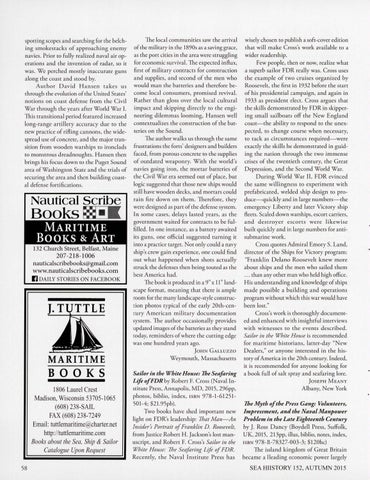spotting scopes and searching for the belching smokestacks of approaching enemy navies. Prior to fully realized naval air operations and the invention of radar, so it was. We perched mostly inaccurate guns along the coast and stood by. Author David H an sen takes us through the evolution of the United States' notions on coast defense from the Civil War through the years after World War I. This transitional period featured increased long-range artillery accuracy due to the new practice of rifling cannons, the widespread use of concrete, and the major transition from wooden warships to ironclads to monstrous dreadnoughts. Hansen then brings his focus down to the Puget Sound area of Washington State and the trials of securing the area and then building coastal defense fortifi cations.
Nautical Scribe Books ~ MARITIME BOOKS & ART 132 Church Street, Belfast, Maine 207-218-1006 nauticalscribebooks@gmail.com www.nauticalscribebooks.com
11 DAILY STORIES ON FACEBOOK
MARITIME
BOOKS 1806 Laurel Crest Madison, Wisconsin 53705-1065 (608) 238-SAIL FAX (608) 238-7249 Email: tuttlemaritime@charter.net http://tuttlemaritime.com Books about the Sea, Ship & Sailor Catalogue Upon Request 58
The local communities saw the arrival of the military in the 1890s as a saving grace, as the port cities in the area were struggling for economic survival. The expected influx, first of military contracts for construction and supplies, and second of the men who would man the batteries and therefore become local consumers, promised revival. Rather than gloss over the local cultural impact and skipping directly to the engineering dilemmas looming, Hansen well contextualizes the construction of the batteries on the Sound. The author walks us through the same frustrations the forts' designers and builders faced, from porous concrete to the supplies of outdated weaponry. With the world's navies going iron, the mortar batteries of the Civil War era seemed out of place, bur logic suggested that those new ships would still have wooden decks, and mortars could rain fire down on them. Therefore, they were designed as part of the defense system. In some cases, delays lasted yea rs, as the government waited for contracts to be fulfilled . In one instance, as a battery awaited its guns, one official suggested turning it into a practice target. Not only could a navy ship's crew gain experience, one could find out what happened when shots actually struck the defenses then being touted as the best America had. The book is produced in a 9" x 11" landscape format, meaning that there is ample room for the many landscape-style construction photos typical of the early 20th-century American military documentation system. The author occasionally provides updated images of the batteries as they stand today, reminders of where the cutting edge was one hundred years ago. JOH N GALLUZZO Weymouth, Massachusetts
Sailor in the White House: The Seafaring Life ofFDR by Robert F. Cross (Naval Institute Press, Annapolis, MD, 2015, 296pp, photos, biblio, index, ISBN 978-1-61251501-4; $21.95pb). Two books have shed important new light on FDR's leadership: That Man-An Insider's Portrait of Franklin D. Roosevelt, from Justice Robert H . Jackson's lost manuscript, and Robert F. Cross's Sailor in the White House: lhe Seafaring Life of FDR. Recently, the Naval Institute Press has
wisely chosen to publish a soft-cover edition that will make Cross's work available to a wider readership. Few people, then or now, realize what a superb sailor FDR really was. Cross uses the example of two cruises organized by Roosevelt, the first in 1932 before the start of his presidential campaign, and again in 1933 as president elect. Cross argues that the skills demonstrated by FDR in skippering small sailboats off the New England coast-the ability to respond to the unexpected, to change course when necessary, to tack as circumstances required-were exactly the skills he demonstrated in guiding the nation through the two immense crises of the twentieth century, the Great Depression, and the Second World War. During World War II, FDR evinced the same willingness to experiment with prefabricated, welded ship design to produce-quickly and in large numbers-the emergency Liberty and later Victory ship fleets. Scaled down warships, escort carriers, and destroyer escorts were likewise built quickly and in large numbers for antisubmarine work. Cross quotes Admiral Emory S. Land, director of the Ships for Victory program: "Franklin Delano Roosevelt knew more about ships and the men who sailed them . .. than any other man who held high office. His understanding and knowledge of ships made possible a building and operations program without which this war would have been lost." Cross's work is thoroughly documented and enhanced with insightful interviews with witnesses to the events described . Sailor in the White House is recommended for maritime historians, latter-day "New Dealers," or anyone interested in the history of America in the 20th century. Indeed, it is recommended for anyone looking for a book full of salt spray and seafaring lore. JOSEPH M EANY Albany, New York
The Myth of the Press Gang: Volunteers, Impressment, and the Naval Manpower Problem in the Late Eighteenth Century by J . Ross Dancy (Boydell Press, Suffolk, UK, 2015, 213pp, illus, biblio, notes, index, ISBN 978-11-78327-003-3; $120hc) The issland kingdom of Great Britain became a I leading economic power largely SEA HIISTORY 152, AUTUMN 2015
